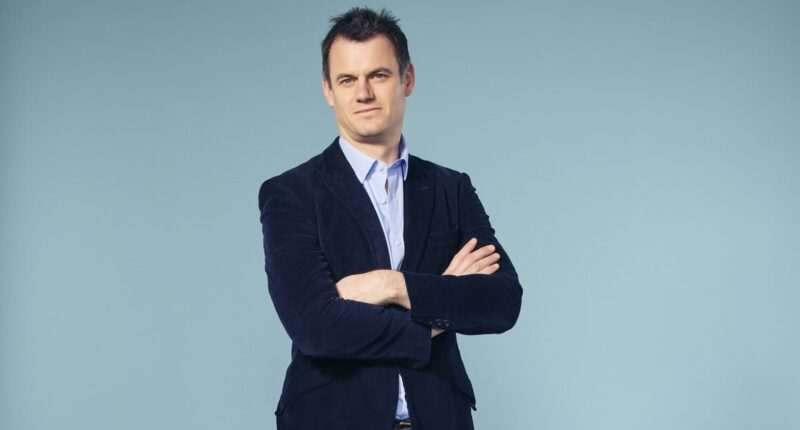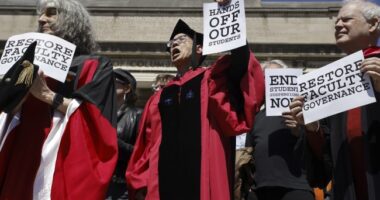What’s the worst thing about middle age? Now there’s a question with no shortage of answers.
I still have nightmares about the time my back went, leaving me doubled over each time I tried to get out of bed or exit the sofa.
For a few awful days, my wife Katie had to help me put my socks on in the morning.
There is 1 paragraph in the content provided.
The entire night I spent nodding vacantly at companions in a trendy restaurant designed for young people, where the acoustics meant I couldn’t hear a bloody thing. The first time my teenage son ever beat me at tennis, punching the air and shouting: ‘Come on!’ I could go on.
For sheer, unbridled horror there is, however, nothing that can quite match the emotion every right-thinking man feels when they gaze into a mirror and realise, for the first time, that they’re slowly but inevitably starting to go bald.
The shame of this development is awfully public. You can try to hide baldness under baseball caps, or experiment with side partings and ‘comb-overs’. You can take what I think of as the ‘Bruce Willis’ option and get a barber to shave the whole lot off so you can pretend having no hair is some sort of lifestyle choice.
You can even copy Prince William and try growing a beard, in the hope it might somehow distract onlookers from the utter devastation unfolding further up your head.

Trichologist Anabel Kingsley gets to work examining Guy’s bald patch. Guy has spent the past six months undergoing cutting-edge therapy at the hands of Britain’s leading hair-loss facility, the Philip Kingsley clinic in London

Guy’s crown is now much fuller. His head has been doused twice-daily in medicated drops and he has consumed a cocktail of supplements and gone through endless bottles of special shampoo, conditioner and soothing minty scalp cream
Such steps are, however, like sticking tape over a gaping wound. As you continue down the slippery slope of hair loss, even the most self-assured chap will question his potency and attractiveness. Eventually, a growing expanse of vacant scalp will start to go shiny, making you resemble a sort of boiled egg.
That, ladies and gentlemen, is biological reality. But we are now living in an era when people have walked on the Moon, conquered Everest, mapped the human genome, and created super-computers capable of feats our ancestors could only dream of. And so it is that, by a miracle of modern medicine, humankind seems to have discovered a ‘cure’ for male pattern baldness.
I say this with some authority, as a 46-year-old man who has spent the past six months undergoing cutting-edge therapy at the hands of Britain’s – and, perhaps, the world’s – leading hair-loss facility, the Philip Kingsley clinic in London.
My bonce has, during this period, been doused twice-daily in medicated drops. I have consumed a cocktail of supplements and gone through endless bottles of special shampoo, conditioner and soothing minty scalp cream.
Every few weeks, I’ve spent a morning at the luxurious clinic, just off Oxford Street, being massaged and generally pampered while mysterious ‘treatments’ are applied under a space-age heating lamp.
The result? Well, you can see it for yourself on these very pages.
As if by magic, my hair is considerably thicker. The bald patch that had appeared on my crown is in retreat. And the dreaded ‘widow’s peak’, which was extending my forehead by a few millimetres each year, has been stabilised.
We are not quite out of the woods. I remain in a relatively early stage of baldness remission and am told that the treatment regime’s full effects won’t peak until Christmas 2025. But a corner has, as they say, very much been turned.
Old chums have started issuing compliments. At a school reunion, an ex-girlfriend remarked I was ‘looking annoyingly young’. Pathetic though it sounds, these things do wonders for a man’s self-esteem.
I should, at this stage, stress that trichology, to give hair loss treatment its scientific name, is not for the faint-hearted.
Doing it properly is, as I am about to explain, onerous and time-consuming. It can also be expensive.
Some of the drugs involved have nasty-sounding side-effects (of which more later) that affect a small proportion of patients. And the non-invasive therapies I have road-tested only really work on patients who are still in the process of losing their hair.

In a world where hair loss is very much reversible, every worried man should make 2025 the year they get themselves a trichologist, writes Guy Adams
If you are one of those poor chaps who are no longer ‘thinning’, but have instead reached the ‘billiard ball’ stage, then a surgical intervention of the Wayne Rooney variety, in which entire hair follicles are grafted onto your head from a donor site, are the only real cure.
For all the rest of us, I can however now offer a simple call to arms: in a world where hair loss is very much reversible, every worried man should make 2025 the year they get themselves a trichologist.
I first arrived at the Philip Kingsley clinic in May, following an unfortunate period when a sporting injury (knee) had forced me to visit sweaty gyms, performing rehabilitation exercises prescribed by a physiotherapist.
The problem with gyms is that they’re full of mirrors. And it was while performing squat-based exercises that I first caught sight of a small, but nonetheless very definite bald patch.
While we weren’t yet in Prince William territory, it was certainly in the ballpark of his younger brother Harry. It was, I decided, time to seek professional help.
My trichologist, Anabel Kingsley, hails from impeccable stock.
Her father, the aforementioned Philip, who died in 2016, was a sort of founding father of British trichology. He set up the clinic in the early 1960s and made a name treating everyone from Laurence Olivier to Audrey Hepburn and various (nameless) members of the Royal Family.
The son of an East End tailor, Philip had stumbled into the profession after taking a job in his uncle’s hairdressing shop, where he became fascinated by the psychological effect that hair loss had on its clients.
He became a pioneer in recognising how stress and nutrition affects baldness, and was one of the first people to make creams and tonics designed to improve a client’s scalp and energise their follicles.
Today, the Philip Kingsley empire takes in clinics in London and New York, plus an extensive range of lotions, potions and supplements that are sold around the world. They see up to 4,000 patients a year, helping everyone from Olympic synchronised swimming teams (who need help coping with chlorine damage) to Hollywood celebrities.
Getting treatment from Anabel and her team begins with a consultation (£200 for a virtual one and £345 to come to the Mayfair clinic). Products, medications and ongoing treatments cost extra.
It’s big money, but there is much at stake. For Anabel, her job can be as much about treating what’s going on inside a patient’s head as what’s going on outside.
‘The truth is that hair loss can cause depression,’ she says, when I apologise for the vanity that has led me to her consulting room. ‘I’ve had clients who tell me they love swimming, but have stopped doing it because of the way their hair fell when they exit the pool, and others who avoid taking photos with friends because they get so distressed.
‘I see some patients who are as young as 17. The younger men often come with their mothers, who tell me their sons have become a shell of themselves, completely different, and withdrawn. It impacts men deeply and they often don’t feel they can talk about it and instead try to tough it out.’
Anabel kicks off our first meeting with a fact-finding chat, before inspecting the top of my head, using a magnifying video camera that projects close-up images onto a screen. Mine reminded me of one of those aerial pictures of a forest shortly after a hurricane, where dense vegetation has been torn away, leaving a smattering of half-broken stumps.

Getting treatment from Anabel and her team begins with a consultation (£200 for a virtual one and £345 to come to the Mayfair clinic)
This grim situation is, she explains, due to an ominous phenomenon called ‘diameter changes’.
Put simply, individual hairs which had previously been thick were now becoming thin and spindly. What’s more, many of my follicles were starting to get smaller and narrower. Ones that in the prime of life were each producing three hairs now contained just one or two.
‘And you have a couple of completely empty follicles and some with very fine hairs left coming out of them.’
This, I am told, is how the long march to baldness begins. When the follicles close up altogether, it makes the scalp become shiny, like a greased ping-pong ball.
Towards the front, my hair was divided between a section ‘where it has receded’ and one ‘where it is receding’. On top, there was evidence of sun damage, with ‘brown spots’ on my scalp. ‘I am not seeing any dandruff flakes,’ she reassured me, ‘so that’s a good thing, and you actually have a reasonably good head of hair, but it’s not as good as it used to be.’
I was then dispatched for blood tests, and asked probing questions about my diet, lifestyle, stress levels and hair care regime.
Within two weeks, a three-pronged treatment strategy was ordered.
The first involved a daily hair-care regime designed to improve the health of my scalp, and therefore its precious follicles.
It involved regular use of Philip Kingsley’s anti-dandruff shampoos and conditioners, plus a stimulating ‘scalp mask’.
Every now and then, I am to pop into the clinic for further conditioning treatments.
The second revolved around daily supplements, including an amino acid called L-lysine, designed to increase protein levels (I was also told to eat more eggs and red meat) and vitamin D tablets. ‘It’s the most common vitamin deficiency,’ Anabel explained. ‘Every follicle contains a vitamin D receptor, and low levels can cause shedding linked to hair loss.’
Thirdly, and most importantly, came medication. Since the 1990s, two different drugs have been quite widely used to treat hair loss. One is called finasteride, and it reduces levels of dihydrotestosterone, the hormone responsible for male pattern hair loss.
The other is minoxidil, which was originally a blood pressure drug but has been widely used to treat baldness after it emerged that it increases blood flow to the scalp.
Traditionally, they have been used independently. But recently, trichologists have experimented with combining them, in potions that include hormones and ingredients such as caffeine.
Anabel has developed therapeutic drops, which I apply morning and night to my scalp, via a pipette, in a process she likens to applying ‘turbo fertiliser’.
I start to notice its effects within a couple of months. By late summer, my hair doesn’t just look different, it feels different, too.
‘The combination we are using was developed a year ago, and we are starting to see amazing results, far better than had been expected,’ is how she puts it.
There is, alas, one fly in the ointment. It involves side-effects. Minoxidil can cause heart palpitations and make your head itchy. A small number of patients who take finasteride have suffered bouts of depression and, alarmingly, loss of libido.
Two weeks after I started taking the drug, a friend emailed me a newspaper article headlined: ‘It made my penis change shape; inside the hair loss drug controversy.’ The Economist ran a similarly chilling piece in April, headlined: ‘Will you risk a breakdown to cure baldness?’
For me, the answer to the second question was a resounding ‘yes’. I was guided to this conclusion by Anabel, who assured me, correctly, that patients who experience side-effects are most commonly ones who take finasteride via daily pills, saying: ‘We like topical treatments instead, because you lower the risk.’
In a further bid to ward off side-effects, she also instructed me to take very low doses for the first couple of weeks, and to monitor for problems. I can happily report that, like roughly 98 per cent of patients who take the products, I have suffered no obvious problems in either the trouser or mental health department. In other words, all is fine.
The only setback has been my tendency to forget to apply the drops before turning in for the night or after waking in the morning. I sometimes find myself leaping from bed, a few minutes after lights out, having belatedly remembered to apply the stuff.
My wife thinks I’m a bit mad, but then she was unbothered by the fact I was losing my hair – ‘I love you whatever’ – so quite rightly couldn’t care less that my bald patch is now disappearing.
Trichology can be an expensive game – the bespoke drops cost £135 for a three-month supply – and I doubt Katie will consider it money well spent in the months and years to come. But this investment was never about her, or anyone else. I am embarrassed to say that it was all about me.
For more information, go to philipkingsley.co.uk/hair-loss

















